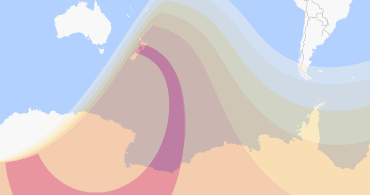This eclipse isn't visible in Wichita - Which upcoming eclipses can be seen in your location?
Where to See the Eclipse
Try our new interactive eclipse maps. Zoom in and search for accurate eclipse Â鶹ӳ» and visualizations for any location.
Path of the Eclipse Shadow
Regions seeing, at least, a partial eclipse: South in South America, Pacific, Atlantic, Antarctica.
This eclipse isn't visible in Wichita - Which upcoming eclipses can be seen in your location?
Eclipse Shadow Path
0%
>0%
40%
90%
100%
The dark areas symbolize night and twilight.
When the Eclipse Happens Worldwide — Timeline
The eclipse starts at one location and ends at another. The Â鶹ӳ» below are actual Â鶹ӳ» (in UTC) when the eclipse occurs. This calculation uses a Delta T value of 85.2 seconds.
| Eclipse Stages Worldwide | UTC Time | Local Time in Wichita* |
|---|---|---|
| First location to see the partial eclipse begin | Oct 24 at 15:45:18 | Oct 24 at 10:45:18 am |
| First location to see the full eclipse begin | Oct 24 at 17:21:46 | Oct 24 at 12:21:46 pm |
| Maximum Eclipse | Oct 24 at 18:09:56 | Oct 24 at 1:09:56 pm |
| Last location to see the full eclipse end | Oct 24 at 18:57:39 | Oct 24 at 1:57:39 pm |
| Last location to see the partial eclipse end | Oct 24 at 20:34:19 | Oct 24 at 3:34:19 pm |
* These local Â鶹ӳ» do not refer to a specific location but indicate the beginning, peak, and end of the eclipse on a global scale, each line referring to a different location. This eclipse isn't visible in Wichita.
Upcoming eclipses visible in Wichita
Next Annular Solar Eclipse will be on Mar 10, 2081
Eclipse calculations usually accurate to a few seconds
Countries Where the Eclipse Is Visible
| Country | Type | Start of Eclipse | End of Eclipse |
|---|---|---|---|
| Antarctica | Annular Solar Eclipse | 3:14 am DDUT | 5:30 pm |
| New Zealand | Annular Solar Eclipse | 6:21 am CHADT | 7:50 am NZDT |
| American Samoa | Partial Solar Eclipse | 5:40 am SST | 6:35 am SST |
| Argentina | Partial Solar Eclipse | 3:39 pm CLST | 5:13 pm ART |
| Australia | Partial Solar Eclipse | 4:52 am | 5:54 am |
| Chile | Partial Solar Eclipse | 12:09 pm EASST | 5:14 pm CLST |
| Cook Islands | Partial Solar Eclipse | 5:51 am CKT | 7:51 am CKT |
| Falkland Islands | Partial Solar Eclipse | 4:06 pm FKST | 5:07 pm FKST |
| Fiji | Partial Solar Eclipse | 5:15 am FJT | 5:53 am FJT |
| French Polynesia | Partial Solar Eclipse | 5:46 am TAHT | 8:09 am TAHT |
| Kiribati | Partial Solar Eclipse | 5:45 am LINT | 7:24 am LINT |
| New Caledonia | Partial Solar Eclipse | 4:55 am NCT | 4:55 am NCT |
| Niue | Partial Solar Eclipse | 5:42 am NUT | 6:45 am NUT |
| Norfolk Island | Partial Solar Eclipse | 6:02 am NFDT | 6:08 am NFDT |
| Pitcairn Islands | Partial Solar Eclipse | 8:03 am PST | 10:04 am PST |
| Samoa | Partial Solar Eclipse | 5:54 am WST | 6:35 am WST |
| South Georgia/Sandwich Is. | Partial Solar Eclipse | 4:58 pm GST | 6:33 pm GST |
| Tokelau | Partial Solar Eclipse | 5:57 am TKT | 6:24 am TKT |
| Tonga | Partial Solar Eclipse | 5:59 am TOT | 6:52 am TOT |
| US Minor Outlying Islands | Partial Solar Eclipse | 5:20 am | 5:54 am |
| Wallis and Futuna | Partial Solar Eclipse | 5:13 am WFT | 5:37 am WFT |
All Â鶹ӳ» shown in this table are local time. (Note: more than one time zone is listed.)

An Eclipse Never Comes Alone!
A solar eclipse always occurs about two weeks before or after a lunar eclipse.
Usually, there are two eclipses in a row, but other Â鶹ӳ», there are three during the same eclipse season.
This is the second eclipse this season.
First eclipse this season: October 10, 2079 — Total Lunar Eclipse

